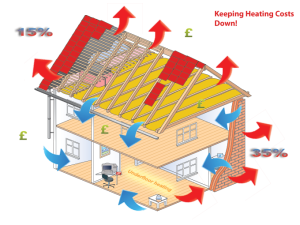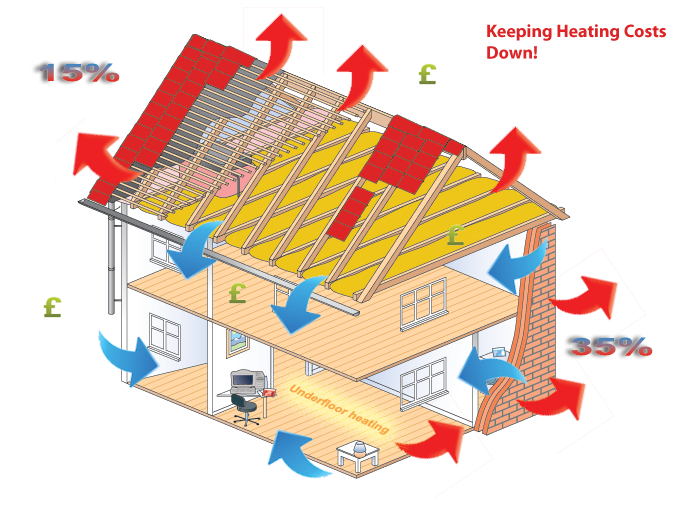The concept of transfer of heat is known to all of us, that energy travels from higher temperature area to lower temperature area to make the latter warmer. This phenomenon works in our homes in summer as well as winters. In summers, the temperature outside the house is much more than the temperature inside the house. This temperature difference causes the energy outside the house to enter the room through roofs and walls and thus, make it warmer. There is a similar process of energy transfer in winters, just that the direction of transfer is opposite.
To reduce this, one uses artificial advancements of science and technology like Air Conditioners and heaters. These methods consume a lot of electricity and are very costly. A very eco-friendly method to reduce the amount of heat transfer is called ‘Insulated Cavity Wall’. In these walls, the air space in cavity walls is filled with an insulator, i.e which inhibits heat transfer.


During construction, walls are filled with glass fibre wool or rock wool panels, which are insulators and do not allow the conduction of heat, thus making the temperature inside the room favourable as compared to outside. In other words, the Insulated cavity wall makes the inside temperature less vulnerable to the outside atmospheric conditions, rather makes it comfortably good inside. So, it is will be your natural air conditioner or heater.
The insulation is of two kinds- Internal or external. Internal insulation means the insulating only one room or part of the room rather than the whole house. In it, only some walls are filled with insulation material, which then makes the room’s temperature different from the rest of the house. External insulation referes to insulating whole of the house in one time.
Both internal and external wall insulation have their own advantages and disadvantages. The former is cheaper to install than the latter one, but none of them is exceedingly expensive. The former reduces the area of the house somewhat, while the latter does not. Also, external wall insulation makes the house sound-proof and increases the life of the walls.
This type of insulation in walls can be very helpful to the environment, if done on mass scale. Try to imagine the reduction in the greenhouse gases when these walls are installed, because of the reduced use of ACs or Room-heaters. This reduction in the use of these electrical appliances will also be favourable for your electricity bill, and ultimately, for your pocket. This also prevents a lot of Carbon dioxide from entering the atmosphere of earth, and thus reduce the global warming.
The only problem which these walls face is of dampness or condensation. There are some complaints which talk about persistent dampness in the wall. The precaution is that any kind of dampness present in the walls must be treated completely and then the insulation cavity should be applied.
Such type of insulation can prove very useful in a country like India, which has extreme climatic conditions. Most of the houses in India do not have any artificial electric appliances to adjust the temperature of the room. If such houses are built in Rajasthan and in other areas of extreme climatic conditions, the innovation can prove a great boon to the residents. If applied in cities, the idea will cut the usage of ACs and Heaters massively. Not only this will reduce the demand of the electricity in the cities, but reduce the emission of greenhouse gases in the enironment.

Insulated Cavity walls are very suitable for a lot of countries and can be used effectively. Concerned governmental authorities should spread awareness about the concept and help the under-construction buildings to implement the method. Promotion in its implementation, if done on a large scale, can result in a movement for reduction of global warming. This is yet another step towards following green living, towards connecting to nature. This process is not very costly, and the cost can be covered within a period of few years because of the lower electricity bills. But it results in benefits to self, and betterment of the planet on the whole.
No doubt Science and Technology have given us methods to cushion our lives, but its excessive use has been responsible for the present condition of the planet. It is our responsibility to shift from conventional ways to eco-friendly methods of living our lives. Surely there are many, like insulated cavity walls. The need is to identify them and bring them in the life style. This is no compromise, but to acknowledge one’s responsibility towards the nature.

Leave a Reply